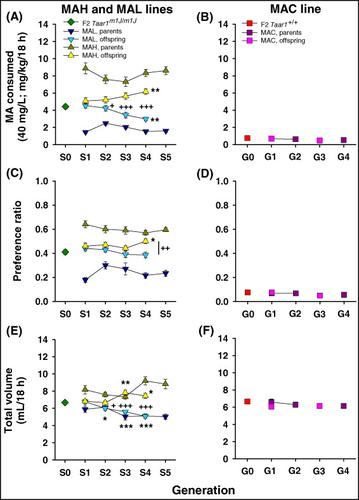当前位置:
X-MOL 学术
›
Genes Brain Behav.
›
论文详情
Our official English website, www.x-mol.net, welcomes your feedback! (Note: you will need to create a separate account there.)
A breeding strategy to identify modifiers of high genetic risk for methamphetamine intake
Genes, Brain and Behavior ( IF 2.5 ) Pub Date : 2020-05-18 , DOI: 10.1111/gbb.12667 Cheryl Reed 1 , Alexandra M Stafford 1 , John R K Mootz 1 , Harue Baba 1 , Jason Erk 1 , Tamara J Phillips 1, 2
Genes, Brain and Behavior ( IF 2.5 ) Pub Date : 2020-05-18 , DOI: 10.1111/gbb.12667 Cheryl Reed 1 , Alexandra M Stafford 1 , John R K Mootz 1 , Harue Baba 1 , Jason Erk 1 , Tamara J Phillips 1, 2
Affiliation

|
Trace amine‐associated receptor 1 (Taar1) impacts methamphetamine (MA) intake. A mutant allele (Taar1m1J) derived from the DBA/2J mouse strain codes for a non‐functional receptor, and Taar1m1J/m1J mice consume more MA than mice possessing the reference Taar1+ allele. To study the impact of this mutation in a genetically diverse population, heterogeneous stock‐collaborative cross (HS‐CC) mice, the product of an eight‐way cross of standard and wild‐derived strains, were tested for MA intake. HS‐CC had low MA intake, so an HS‐CC by DBA/2J strain F2 intercross was created to transfer the mutant allele onto the diverse background, and used for selective breeding. To study residual variation in MA intake existing in Taar1m1J/m1J mice, selective breeding for higher (MAH) vs lower (MAL) MA intake was initiated from Taar1m1J/m1J F2 individuals; a control line of Taar1+/+ individuals (MAC) was retained. The lines were also examined for MA‐induced locomotor and thermal responses, and fluid and tastant consumption. Taar1m1J/m1J F2 mice consumed significantly more MA than Taar1+/+ F2 mice. Response to selection was significant by generation 2 and there were corresponding differences in fluid consumed. Fluid consumption was not different in non‐MA drinking studies. Taar1m1J/m1J genotype (MAL or MAH vs MAC mice) was associated with heighted MA locomotor and reduced hypothermic responses. MAL mice exhibited greater sensitization than MAH mice, but the selected lines did not consistently differ for thermal or tastant phenotypes. Residual variation among high‐risk Taar1m1J/m1J mice appears to involve mechanisms associated with neuroadaptation to MA, but not sensitivity to hypothermic effects of MA.
中文翻译:

确定甲基苯丙胺摄入高遗传风险修饰因子的育种策略
痕量胺相关受体 1 ( Taar1 ) 影响甲基苯丙胺 (MA) 的摄入量。源自 DBA/2J 小鼠品系的突变等位基因 ( Taar1 m1J ) 编码非功能性受体,并且Taar1 m1J/m1J小鼠比拥有参考Taar1 +的小鼠消耗更多 MA等位基因。为了研究这种突变对遗传多样性人群的影响,异种库存协作杂交 (HS-CC) 小鼠(标准品系和野生衍生品系的八种杂交产物)进行了 MA 摄入量测试。HS-CC 的 MA 摄入量较低,因此通过 DBA/2J 菌株 F2 杂交创建了一个 HS-CC,将突变等位基因转移到不同的背景上,并用于选择性育种。为了研究Taar1 m1J/m1J小鼠中存在的 MA 摄入量的残余变化,从Taar1 m1J/m1J F2 个体开始选择性育种更高(MAH)与更低(MAL)MA 摄入量;Taar1的控制线+/+个人(MAC)被保留。还检查了这些线的 MA 诱导的运动和热反应,以及液体和味觉的消耗。Taar1 m1J/m1J F2 小鼠比Taar1 +/+ F2 小鼠消耗的 MA 显着更多。第 2 代对选择的反应显着,消耗的液体也有相应的差异。在非 MA 饮酒研究中,液体消耗量没有差异。Taar1 m1J/m1J基因型(MAL 或 MAH 与 MAC 小鼠)与高 MA 运动和降低的低温反应相关。MAL 小鼠表现出比 MAH 小鼠更高的致敏性,但所选品系在热或味觉表型方面并没有始终如一的差异。高风险Taar1之间的残差变异m1J/m1J小鼠似乎涉及与 MA 的神经适应相关的机制,但对 MA 的低温效应不敏感。
更新日期:2020-05-18
中文翻译:

确定甲基苯丙胺摄入高遗传风险修饰因子的育种策略
痕量胺相关受体 1 ( Taar1 ) 影响甲基苯丙胺 (MA) 的摄入量。源自 DBA/2J 小鼠品系的突变等位基因 ( Taar1 m1J ) 编码非功能性受体,并且Taar1 m1J/m1J小鼠比拥有参考Taar1 +的小鼠消耗更多 MA等位基因。为了研究这种突变对遗传多样性人群的影响,异种库存协作杂交 (HS-CC) 小鼠(标准品系和野生衍生品系的八种杂交产物)进行了 MA 摄入量测试。HS-CC 的 MA 摄入量较低,因此通过 DBA/2J 菌株 F2 杂交创建了一个 HS-CC,将突变等位基因转移到不同的背景上,并用于选择性育种。为了研究Taar1 m1J/m1J小鼠中存在的 MA 摄入量的残余变化,从Taar1 m1J/m1J F2 个体开始选择性育种更高(MAH)与更低(MAL)MA 摄入量;Taar1的控制线+/+个人(MAC)被保留。还检查了这些线的 MA 诱导的运动和热反应,以及液体和味觉的消耗。Taar1 m1J/m1J F2 小鼠比Taar1 +/+ F2 小鼠消耗的 MA 显着更多。第 2 代对选择的反应显着,消耗的液体也有相应的差异。在非 MA 饮酒研究中,液体消耗量没有差异。Taar1 m1J/m1J基因型(MAL 或 MAH 与 MAC 小鼠)与高 MA 运动和降低的低温反应相关。MAL 小鼠表现出比 MAH 小鼠更高的致敏性,但所选品系在热或味觉表型方面并没有始终如一的差异。高风险Taar1之间的残差变异m1J/m1J小鼠似乎涉及与 MA 的神经适应相关的机制,但对 MA 的低温效应不敏感。



























 京公网安备 11010802027423号
京公网安备 11010802027423号